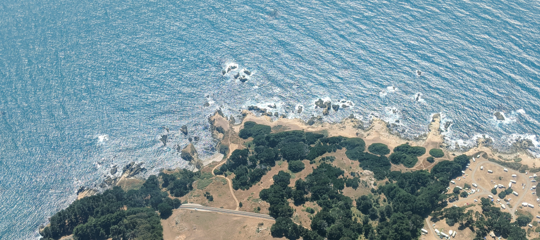
North Coast Climate Change Adaptation Strategy
Greenhouse gas emissions largely from fossil fuel combustion have increased the retention of heat or thermal radiation in the atmosphere. This global warming process drives climate change that affects the spatial and statistical distributions of present temperature and precipitation patterns. These effects cascade into impacts as human and natural systems react to shifts in long-standing weather patterns. Climate change impacts to North Coast watersheds and beneficial uses may be numerous given the region’s geographical breadth.

- Water demand for crops and ecosystem services increasing from longer, hotter summers
- Increased flood frequency in low-lying areas
- Reduced snowpack from warmer air temperatures
- Increased wildfire frequency and severity
- Altered precipitation patterns influencing drought duration and storm intensity
- Increased surface water temperatures affecting aquatic habitat
- Altered ecosystems and increased threat to vulnerable species
In addressing climate change, the North Coast Regional Water Quality Control Board adopted the 2014 Triennial Review that prioritizes climate adaptation. The recently adopted 2018 Triennial Review has identified the initial steps required for adaptation to climate change impacts, as part of the development of a Climate Change Adaptation Strategy. These initial steps include developing or modifying existing methodology to perform a landscape assessment in GIS. The State Water Resources Control Board has adopted a comprehensive resolution to address climate change impacts. This climate portal for the North Coast Regional Water Board provides information on the past, current, and future activities related to climate change adaptation.
Contact Us
- Lance Le
Water Resource Control Engineer
(707) 576-6727
Lance.Le@waterboards.ca.gov - Lisa Bernard
Senior Environmental Scientist
(707) 576-2677
Lisa.Bernard@waterboards.ca.gov - Alydda Mangelsdorf
Planning and Stewardship Division Chief
(707) 576-2677
Alydda.Mangelsdorf@waterboards.ca.gov
Water Board Activites
Resources
Local Initiatives
- Humboldt Bay Sea Level Rise Adaptation Planning Project
- Terrestrial Biodiversity Climate Change Collaborative
- Sonoma County Climate Resilience Team
- North Bay Climate Adaptation Initiative
- Humboldt Baykeeper: Climate Change Impacts
- Coastal Conservancy and Climate Change
- White Slough Tidal Wetlands Restoration Project
- Rohner Creek Flood Control, Habitat and Seismic Improvement Project


